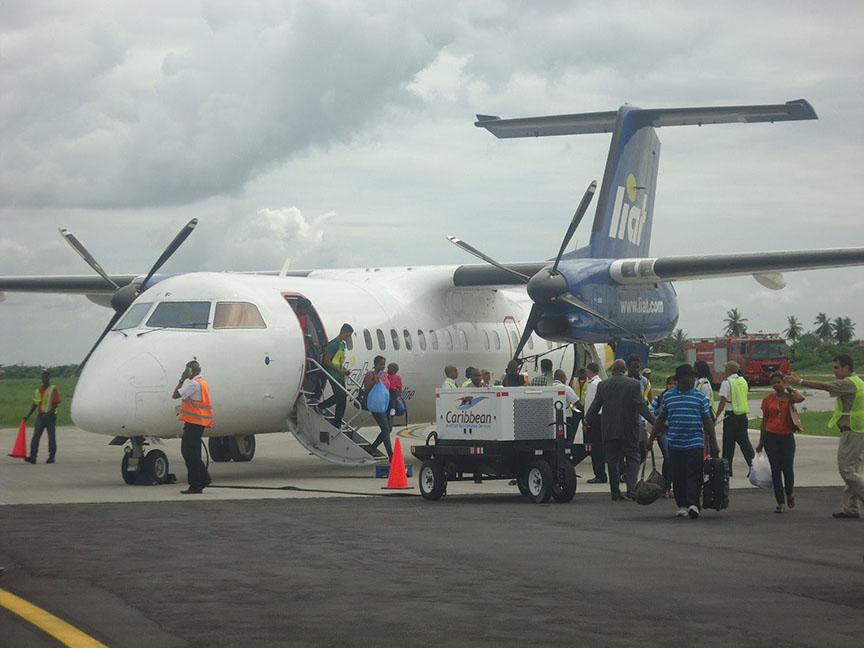A near 16 per cent increase in visitor arrivals here in 2018 over that recorded in 2017 reflects a marginal rise in visitor preference for the ‘Land of Many Waters’ though the numbers continue to place Guyana well behind some of the tourism ‘hot spots’ in the region in terms of favoured destinations in the Caribbean.
Visitor arrival figures released to the Stabroek Business by the Guyana Tourism Authority indicate that the numbers reaching here climbed to 286,732, up from 247,330 in 2017. What the GTA’s statistics also indicate is that despite the growing popularity of the Eugene F Correia International Airport (EFCIA) as the favoured final stop on their travel to Guyana, the Cheddi Jagan International Airport (CJIA) maintains its status as the country’s busier airport. Last year, visitor arrivals at CJIA jumped to 231,512, compared with 197,048 in 2018. Arrivals at EFCIA last year reached 23,608 compared with 19,272 last year.
Smaller number of visitors continue to arrive here through the country’s lesser known ports of entry. Last year, arrivals through Lethem fell marginally to 9,136 from 9,517 in 2017. Arrivals through Molsen Creek rose to 22,476 last year from 21,493 in 2017.

The attraction of a Guyanese Christmas meant that December continues to be the busiest month in terms of visitor arrivals. Last year’s 29,059 December arrivals was appreciably larger than the 26,866 visitors received during the same month in 2017. The second busiest month for visitor arrivals during both years was November. In 2017 21,042 visitors found their way to Guyana during the month of November whilst 23,323 persons arrived in Guyana through its various ports in November 2018.
Meanwhile, visitor arrival statistics over the past 22 years reflects a positive change in the pattern of overall visitor arrival here over the period. During the period between 1996 and 2012 visitor arrivals remain pegged below 200,000, though since 2013 the numbers have jumped above 200,000 and have remained there ever since. The GTA’s current statistics indicate that the 286,732 visitors who came here last year was the highest visitor number over the 22-year period.
Statistics provided for “visitor arrivals by main markets” point to a runaway lead for visitor arrivals here from the United States, though the figures provided by the GTA reflect a sustained jump in the numbers arriving here since 2010. Last year’s 89,456 arrivals from the United States was marginally below the 90,567 arrivals here in 2016, the year of the 50th anniversary of Guyana’s attainment of Independence. Visitors to Guyana from Caribbean territories as a whole numbered 137,433 in 2018 compared with 107,329, numbers which continue to reflect the low level of visits to Guyana from its CARICOM partners despite the convenience of travel. Even now, a sizeable number of regional visitors arrive in Guyana either on business on work-related duties, a circumstance that reflects the limited success which Guyana has realized up to this time in ‘selling’ the rest of the region the attractions of its interior and ecotourism attractions.
Canada follows the Caribbean and the United States in terms of the numbers of visitors finding their way to Guyana though visitors in 2018 fell marginally from 24,071 in 2017 to 23,977 last year.
Figures provided for visitor arrivals in Guyana from South and Central America reflect the historical challenges of travel between Guyana and her continental neighbours. Comparisons between the numbers of visitor arrivals here from South and Central America reflect a marginal increase to 16,191 visitors last year from 15,950 in 2017. Even so, visitor numbers to Guyana from South and Central America last year were the second lowest level of visitor arrivals to Guyana from the region in more than five years.
A year ago, government having continually failed to deliver on its promises to pour more resources into promoting Guyana as a tourist destination, the coalition administration recruited the American sustainable development expert Brian Mullis as Head of the Tourism Authority. The Authority has recently released an outline of its Marketing and Development Plan for the sector this year which includes a number of destination development objectives including providing support for the improvement of infrastructure and accessibility, strengthening safety, quality and sustainability standards and regulations, scaling up service quality, training and resource efficiencies and growing market awareness and demand.





